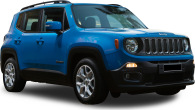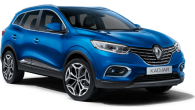Plenty of fanfare accompanied the arrival of the new D-Max ute from Isuzu, with the new HiLux-botherer more powerful, safer and more technologically advanced than its predecessor.
And where a new D-Max goes, its ute-based SUV sibling, the MU-X, must follow. And sure enough, the new rugged but family friendly SUV has now arrived in Australia, too, presenting a serious off-road and towing option for our market, and one that promises to be more comfortable and more tech-savvy than the model it replaces.
This new MU-X returns to the market with a sharper set of clothes, a prettier face, more grunt under the restyled snout and a whole swag of new features to tempt buyers out of an Everest, Fortuner or Pajero Sport.
Not that it’s had trouble doing that thus far, with Isuzu’s MU-X claiming the title of the number-one selling 'ute-based SUV' for the past seven years. This one, though, doesn’t have the same bargain-basement price tag that it had on debut just under a decade ago.
Putting seven bums on seats, towing toys and getting well off the beaten track is all within its scope, so the Japanese brand’s wagon is seen as a jack of all trades. But - like some tradies - was once a little rough around the edges in terms of refinement and road manners.
The new-look model goes a long way to answer some of those criticisms and looks to offer improved levels of comfort.
We’re getting to grips with the flagship LS-T, but first, let’s look at the new range in its entirety.
Isuzu MU-X 2022: LS-M (4X2)
| Engine Type | Diesel Turbo 4, 3.0L |
|---|---|
| Fuel Type | Diesel |
| Fuel Efficiency | 7.8L/100km (combined) |
| Seating | 7 |
| Price From | $39,160 - $46,090 |
| Safety Rating |
|
Does it represent good value for the price? What features does it come with?
7 / 10
Entry to the new MU-X range, which is offered with rear and 4WD models on all three tiers, starts with the MU-X LS-M, priced from $47,900 for the 4X2 and $53,900 for the 4X4 – price increases of $4000 and $2700 respectively.
While it’s not a hose-out mud-plugger, the LS-M is still the rough’n’ready version of the range, with black sidesteps, cloth trim, manual front seat adjustment (including height for the driver), plastic steering wheel and carpet flooring, but it still gets the long-awaited rear diff lock and electric park brake.
A 7.0-inch multimedia screen offers access to digital radio, as well as wireless Apple CarPlay and Android Auto, delivering the results through four speakers.
.jpg)
There’s manual air conditioning with roof-mounted rear vents and a separate fan control to keep the rear rows well-ventilated.
Unlike some entry-level models, the base model here isn’t deprived on the lighting front, with the automatic bi-LED headlights (auto-levelling and with automatic high-beam control), as well as LED daytime running and rear lights, rain-sensing wipers, rear parking sensors and a reversing camera.
The middle child of the MU-X family is the LS-U, and it offers a little more comfort to the occupants and some nicer exterior touches, too, helping justify the price jump to $53,900 ($7600 over the outgoing vehicle) for the 4x2, and $59,900 for the 4x4 model, rising $6300 over the superseded model.
Body-coloured exterior mirrors and door handles replace the black plastic trim of the base model, with roof rails, rear ‘privacy’ glass and LED foglight added to the list. The front grille also changes to silver and chrome, the alloy wheels grow to 18 inches and are now wrapped in highway-biased rubber.
.jpg)
Also growing - by two inches - is the centre infotainment display, which adds integrated satellite navigation and voice recognition to its repertoire, as well as doubling the number of speakers to eight.
Dual-zone climate-control, LED-lit front vanity mirrors for both front occupants, front parking sensors and a remote powered rear tailgate are among the other extras added, while the exterior sidesteps are now silver.
The interior is accessed by keyless ‘smart’ entry (with auto-locking once the driver wanders more than three metres away) and while the cloth trim is retained, it’s a higher grade and the cabin is littered with piano black, silver and chrome highlights.
For the driver there’s now a leather-wrapped wheel and gear-shifter, as well as a powered lumbar-support adjustment.
The flagship of the new MU-X range remains the LS-T. Chief among the changes that will betray its top-spec nature are the attractive two-toned machined alloy wheels and the leather-trimmed interior.
The top-spec model sneaks in at $59,900 for the 4x2 (up a substantial $9,800), and rises to $65,900 for the 4WD model, which is a $8500 jump over the old model.
That buys a two-inch jump in wheel size to 20 inches, and “quilted” leather trim for the seats, interior door trims and the centre console, as well as two-stage seat heating for the two front seats.
The LS-T’s driver’s seat boasts eight-way power-adjustment, with LED ambient interior lighting, embedded ambient lighting in the gear selector, tyre pressure monitoring and an auto-dimming centre mirror among the extras for the driver.
Buyers of the flagship will also benefit from the remote engine-start function, ideal for cooling a long-parked car on Australian summer days.
In terms of its competitive set, the MU-X increased price tag hasn’t pushed it beyond the parameters set by its competition, but it does erode the Isuzu’s value advantage.
Ford’s Ranger-based Everest starts at $50,090 for the RWD 3.2 Ambiente and tops out at $73,190 for the Titanium 2.0 4WD model.
Toyota’s Fortuner offers only a 4WD model for its Hilux-based wagon, which starts at $49,080 for the entry-level GX, rising to $54,340 for the GXL and finishing with the Crusade at $61,410.
Mitsubishi’s Pajero Sport starts from $47,490 for the GLX five-seater, but for a seven-seater it’s the GLS - priced from $52,240 - that’s required; the Triton-based wagon range tops out at $57,690 for the Exceed seven-seater.
Is there anything interesting about its design?
7 / 10
There’s plenty of family resemblance between the D-MAX utility and its wagon sibling – that’s a good thing as the new look has been well-received.
Sculpted flanks and more shoulders shape have replaced the somewhat slab-sided look of its predecessor, with the wheel arch flares now a little more integrated into the sides of the new MU-X.
.jpg)
The awkward window treatment on the rear corner of the outgoing MU-X has been replaced by a slimmer C-pillar and a more conventional window shape, which suggests a better view for those seated in the third row.
The strong shoulder line and a squarer stance gives the MU-X plenty of presence on the road, with eye-catching styling at the front and the rear, the latter probably more in need of attention than the snout in the case of the previous MU-X.
.jpg)

How practical is the space inside?
7 / 10
Second only to the Ford Everest in overall length, the MU-X sits at 4850mm long - a 25mm increase - with 10mm of that added to the wheelbase that’s now 2855mm long, 5mm longer than the Ford.
The new MU-X is 1870mm wide and 1825mm tall (1815mm for the LS-M), up 10mm, although the wheel track remains unchanged at 1570mm.
The ground clearance has improved by 10mm to 235mm for all bar the 230mm listed for the LS-M base-model.
What has reduced - by 35mm - is overall height to sit below the Everest, Pajero Sport and Fortuner rooflines, with a 10mm reduction in front overhang and a 25mm addition to the rear overhang.
Cargo and cabin space have benefitted from the dimensional improvements. The former in particular has risen – with all seats occupied the maker claims 311 litres of luggage space (up from 286 in the outgoing vehicle), rising to 1119 litres (measured to SAE standard) in five-seater mode, an improvement of 68 litres.
.jpg)
If there’s a sojourn to a Swedish furniture warehouse on the cards, with the second and third rows folded the new MU-X boasts 2138 litres, which is a slight reduction on the outgoing model’s 2162 litres.
The cargo space is, however, more user-friendly in the way the seating can folded to provide a flat loadspace.
.jpg)
The boot is accessed by a higher-opening tailgate and there’s underfloor storage as well, which can be utilised when all three rows are occupied.
Flexibility is king in these SUVs and the new MU-X can offer myriad interior seating and cargo options.
.jpg)
The width within feels sufficient in the front two seats, the occupants of which have access to plenty of storage in the console or dashboard, with two gloveboxes.
Neither are massive but there’s a decent amount of useful space, marred only by an odd boxed section in the upper glovebox that looks to have been made for something not offered in this market.
The centre console under the driver’s left elbow has a useful amount of space, but it’s more likely you’ll use the console storage ahead of the gear selector.
It’s ideal for phones and is just screaming out for a wireless charging pad in addition to the USB and 12-volt outlets already there.
.jpg)
That said, the latter was strangely devoid of current – we couldn’t get a number of different plugs to work in the front or rear 12-volt outlet.
The door pockets front and rear can carry a 1.5-litre bottle, part of a cohort of a dozen beverage holder options.
Front occupants get two cupholders in the centre console and one under each outboard vent, which function well great for keeping drinks warm or cool - there’s a similar set-up in the Toyota duo too.
The middle row has the only ISOFIX mounts - on the outboard seats - and tethers for all three positions, as well as cupholders in the armrest and two USB charge points; there are vents and fan controls in the roof (but no roof speakers any more).
.jpg)
The backrests of the front seats are equipped with map pockets, as well as a shopping bag hook on the passenger’s side.
Sadly there’s no sign of a three-pin domestic power plug for 230-240 volt devices that pops up on its opposition.
The seat base doesn’t slide for the second row to tailor its legroom but the backrest does recline a little.
At 191cm I can sit behind my own driving position, with some margin for head and legroom; time in the third row would need to be limited to short trips unless you’re in the single-digit age bracket.
.jpg)
Two cupholders sit outboard of the third row, along with some oddment storage.
There’s no USB outlets but the 12-volt outlet in the cargo area would work in a pinch if it could be convinced to supply power.
The powered rear tailgate emitted a triple-beep and refused to open, a function we later found out was instigated by the presence of a trailer plug in the socket.
Just as the rear parking sensors now recognise the presence of a trailer when in reverse, the tailgate function was designed to prevent it hitting anything on the tow ball. Let’s hope the same level of attention to feedback is focussed on the active safety system functionality and switches.
What are the key stats for the engine and transmission?
8 / 10
The 3.0-litre turbo-diesel four-cylinder engine is a staple of the Isuzu range, and this new powerplant is very much an exercise in evolution over revolution. If it ain’t broke, don’t fix it.
So the new MU-X is powered by the 4JJ3-TCX – a 3.0-litre, common-rail, direct-injection four-cylinder turbo-diesel engine that is a descendant of the outgoing MU-X powerplant, albeit with additional exhaust emissions gear to reduce output of nitrogen oxide and hydrogen sulphide.
But Isuzu claims the extra focus on emissions hasn’t harmed the outputs, which have grown by 10kW to 140kW at 3600rpm and there’s a 20Nm increase in torque to 450Nm between 1600rpm and 2600rpm.
The new engine has a variable geometry turbocharger (although now with electric control) force-feeding the engine to good effect, with new block, head, crankshaft and aluminium pistons and a higher-mounted intercooler.
.jpg)
As was the case with previous incarnations of the wagon and its utility sibling, the relaxed midrange torque of this under-stressed engine is what appeals to many drivers indulging in towing and off-roading.
Isuzu claims the midrange torque output has improved, with 400Nm on offer from 1400rpm through to 3250rpm and 300Nm is produced from just 1000rpm, assertions that have a ring of truth in them after some time behind the wheel.
Isuzu has avoided a selective catalytic reduction (SCR) system that requires AdBlue, instead choosing a lean nitrogen oxide (NOx) trap (LNT) that minimises nitrogen oxide (NOx) emissions to Euro 5b standards.
There’s also a new high-pressure direct injection fuel system featuring a 20 per cent more efficient fuel pump, sending the diesel through new high-efficiency injectors into the newly-engineered combustion chamber.
A maintenance-free steel timing chain is claiming to be quieter and more durable by way of a double scissor idle gear set that Isuzu says improves durability and reduces engine rattle and vibration.
.jpg)
That does come through in the drive, with lower levels of engine noise in the cabin, but there’s no doubting the engine type under the bonnet.
A six-speed automatic and part-time 4WD system is also carried over from the workhorse sibling, a transmission that’s had work done to improve shift quality and speed, something that’s apparent from time behind the wheel.
The addition of a rear differential lock will also please off-roaders, but a rear-drive or full-time option for the 4WD system for sealed surfaces is still exclusive to the Mitsubishi Pajero Sport.
The auto has retained its smarts when it comes to down-changing for engine braking on long descents, something that can be done by manual change as well - it won’t over-rule and up-change against the driver’s wishes in manual mode either.
How much fuel does it consume?
8 / 10
Any fuel economy claim in single digits is going to be pleasing to the pump-watchers, and the MU-X is one for the fuel-misers, despite its thirst going up just under half-a-litre per 100km over its predecessor.
Combined cycle fuel economy claims range stand at 7.8 litres per 100km for the rear-wheel drive MU-X models, rising slightly to 8.3 litres per 100km for the 4x4 side of the range.
Mind you, this is over a 20-minute test cycle in an emissions laboratory in two uneven timeframes, weighted toward the urban cycle which has a 19km/h average speed and plenty of time at idle while the shorter highway cycle records a 63km/h average speed and a peak of 120km/h, which we would of course never do here.
After we had covered almost 300km the MU-X LS-T was - according to its trip computer - averaging 10.7 litres per 100km, at a 37km/h average speed, which betrays the largely metropolitan duties performed to that point, with no towing or off-roading.
That would, in theory, bring the touring range down to somewhere around 800km from the newly expanded 80-litre fuel tank, a 15-litre increase in tank capacity, although there’s no reason to doubt the long-legged touring number of 7.2 litres per 100km (the laboratory highway figure).
The fuel economy rose to 11.7 litres per 100km after a 200km round trip with horse float and four-legged occupant, having hovered in the region of 10 litres per 100km (at a 38km/h average speed) for the day-to-day duties prior.
Warranty & Safety Rating
What safety equipment is fitted? What safety rating?
9 / 10
A major step forward for Isuzu’s family wagon has been in the safety features list, which is now comprehensively packed with active and passive safety equipment.
While we had the LS-T on test the ANCAP crash-testing brigade completed their assessment of the new Isuzu wagon and delivered a five-star ANCAP result under the most recent testing regime, not entirely unexpected given the D-MAX on which it is based scored a similarly-high ranking.
The body is 10 per cent stiffer and stronger, thanks to the use of ultra-high strength steel in the bulkhead, sills and body pillars; compared with the previous MU-X, Isuzu claims the new body uses twice the amount of high- and ultra-high tensile steel in the construction.
The brand says it has also engineered an extra 157 spot welds have been added across key areas of the body during the manufacturing process to improve strength and rigidity.
Inside the cabin there are eight airbags that cover all three rows, with the front occupants getting the most protection - the driver and front passenger get dual front, driver’s knee, dual side and curtain airbags, the latter stretching back to the third row.
There’s also a front-centre airbag - far from common in any vehicle segment - which protects front-seat occupants from head collisions in a crash.
But the features designed to prevent an impact in the first place is where the MU-X has made much ground, with its 3D-camera-based Intelligent Driver Assistance System (IDAS) to detect and measure obstacles - vehicles, pedestrians, cyclists - to reduce the severity or event prevent an incident.
The MU-X range has automatic emergency braking with turn assist and forward collision warning, adaptive cruise control with stop-go function,
There’s also ‘Misacceleration Mitigation’, a mouthful which equates to a system that prevents the driver from unintentionally driving into the obstacle in front during slow speed situations of up to 10km/h, as well as rear cross-traffic alert, blind spot monitoring and driver attention monitoring are all part of the safety arsenal.
The multi-faceted lane keeping assist system is operational above 60km/h and will either alert the driver when the vehicle is venturing out of the lane or actively steer the MU-X back towards the centre of the lane.
The only fly in the safety ointment is the driver needs 60 to 90 seconds before getting underway to snooze or turn off some of the active safety systems, which are in some instances far from subtle and an annoyance to the driver.
Most brands manage to have less involved processes - involving in most cases a single albeit long push of one button to distract, disable or decrease the lane departure and blindspot correction and warnings.
Perhaps all the blank buttons left over on either side of the gear selector could be utilised for these systems, rather than being buried in the centre display menu via the helm-mounted controls?
Isuzu have had some feedback on this and says other options are being considered.
The new MU-X has also been endowed with better braking performance with bigger front ventilated discs, which now measure 320mm in diameter and 30mm thick, up 20mm in diameter; the rear discs measure an unchanged 318x18mm.
Also new is the electronic park brake with automatic hold function, something that has not yet appeared in its utility sibling.
Key among the tasks likely to be completed by vehicles in this segment is towing - heavy cumbersome things like boats, caravans or horse floats.
It’s an area where the new MU-X is going to make ground, boasting a 500kg increase in braked towing capacity to 3500kg, within a gross combined mass of 5900kg.
Here’s where the shell-game of weights on trailers and in vehicles comes into play.
With a gross vehicle mass of 2800kg - a kerb weight of 2175kg and a 625kg payload - a full load on the tow ball of 3.5 tonnes would leave just 225kg of payload within the MU-X.
.jpg)
The Isuzu matches Ford’s Everest for GCM, of 5900kg, with the Pajero Sport listed at 5565kg and Toyota’s Fortuner GCM coming in at 5550kg; the Ford and Toyota both claim braked towing capacity of 3100kg and the Mitsubishi sits at an even 3000kg.
But the 2477kg Ford with its 3100kg maximum braked load on the tow bar has 323kg of payload remaining, whereas the lighter Toyota with the same braked towing claim has 295kg of payload to spare.
Mitsubishi’s three-tonne braked towing capacity and its 2110kg kerb weight leaves 455kg of payload within the 5565kg gross combined mass.
What does it cost to own? What warranty is offered?
8 / 10
Isuzu has backed the new MU-X to a greater extent than most of its opposition, starting with a six-year/150,000km factory warranty.
The MU-X has “up to” seven years roadside assistance when serviced through Isuzu dealer network under the seven-years capped price servicing program, which the brand says is around 12 per cent cheaper than that of the superseded model.
Maintenance is required every 15,000km or 12 months, which puts it at the top end of the spectrum for intervals (Toyota still sits at six months or 10,000km while Mitsubishi and Ford match the MU-X interval), with capped price servicing between $389 and $749 for a seven-year total of $3373.
What's it like to drive?
8 / 10
What is immediately apparent - even when first started and driving in cold conditions - is the lower noise levels in the cabin.
Certainly occupants are still aware there’s a four-cylinder diesel toiling away under the snout, but it’s far more distant than in the previous car, something that can also be said for exterior noise in general.
The leather-trimmed seating is comfortable from all reports across three rows, although the third row space is snug for those heading into their teens, but the view is improved over the outgoing car.
Ride comfort from the new front and rear suspension set-ups has improved, without too much body roll or sagging under towing loads; the steering feels better-weighted and less remote than in the car it replaces, with an improved turning circle.
.jpg)
The front end has an all-new double wishbone design with stiffer spring rates and a redesigned anti-roll bar, while the rear has a five-link coil sprung set-up with a wider rear anti-roll bar to handle an increased payload when towing, whilst still remaining comfortable when unladen, says Isuzu.
A sojourn with horse float behind showed some dipping under load - as you’d expect - but ride wasn’t severely impacted and the engine’s meaty mid-range rose to the task.
A load-distribution hitch might well be worth selecting from the accessories catalogue if hefty towing loads are likely to be a regular chore.
The automatic transmission has kept its intuitive shifting smarts, down-changing on descents when the driver’s inputs suggest it’s required.
.jpg)
I also made use of the manual change mode, where the auto doesn’t overrule the driver, but it’s far from requisite behaviour when towing except perhaps to prevent over-eager up changes to 6th gear.
Dropping the nag and float from the tow bar and there was a brief flirtation with the 4WD selector and the rear diff lock, with low range demonstrating a quicker operation.
Useful wheel travel from the revamped rear end showed good traction going over the large suspension-test hump, where improved off-road angles meant no graunching and the road rubber had no dramas dealing with long wet grass as a result.
A short stint of beach driving - on road tyres in high range - demonstrated the prowess of the Isuzu seven-seater in soft sand but it needed the electronics switched off to prevent undue interference.
.jpg)
Low range not needed until the very soft sand was encountered and the new rear diff lock never looked like being required, so clearly we need to find more serious terrain.
The area where the MU-X needs more development is in some of the functional operations for the driver - it seems odd, for example, that the radio stations list can’t be accessed when on the move but all the settings menu (at least on the centre display) can be modified.
The wheel controls are also in need of some work, with the “mute” and “mode” functions on the same button, yet there’s a blank to its left that could be used?
On the right-hand spoke the menu function for accessing the active safety functions - some of which are abrupt and require disabling prior to towing - is overly involved and can only be accessed when stationary.
It can take up to 60 seconds (when you know what you need to find) to snooze or disable these functions and it needs to be done every time you start the vehicle. Isuzu have received feedback on this issue and maintain they are looking into it.
Verdict
So many SUVs are bought by – if you’ll pardon the blunt term – breeders who want to look like explorers, with the closest they get to an off-road situation being the school oval when setting up for the fair.
The MU-X isn’t one of those SUVs … its swagger says beach boat launch not boutique car park, with genuine off-road ability and towing prowess. It just happens to cope with suburban duties without being grumpy about, look decent and be able to carry half your offspring’s soccer team when needed.
Isuzu have done plenty to keep the MU-X at the top of its segment. Pricing is no longer the advantage it once was but it’s still packing the attributes on several fronts for a fair fight.
Pricing Guides

.jpg)

.jpg)
.jpg)
.jpg)
.jpg)
.jpg)
.jpg)
.jpg)
.jpg)
.jpg)
.jpg)
.jpg)
.jpg)
.jpg)
.jpg)
.jpg)
.jpg)
.jpg)
.jpg)












































 copy.png)













.jpg)
.jpg)


.jpg)

